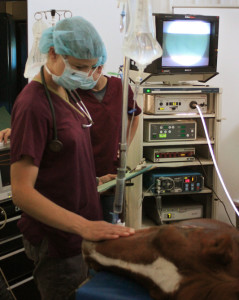 Surgical Anesthesia
Surgical Anesthesia
We take many precautions to provide the safest level of anesthesia for every patient. Prior to anesthesia, the patient is given light sedation to minimize anxiety, and a combination of antibiotics and anti-inflammatory medications. Then the patient is moved into a specially-designed stall and anesthetic drugs are administered for surgical anesthesia.
During surgery, the staff anesthetist uses our specialized equipment to maintain the horse’s respiratory functions and a safe plane of anesthesia. We closely monitor tissue oxygenation, anesthetic gas delivery, direct arterial blood pressure, ECG activity, ventilation pressures and volumes, and blood gas measurements so that we can address the individual needs of each patient throughout the surgical process, thus minimizing the inherent risks.
After the surgical procedure has concluded, the horse returns to one of our specialized recovery stalls. Our recovery stalls were designed with non-skid flooring and padded walls to minimize injury risk. During this time, we continue to monitor, and provide supplemental oxygen whenever necessary. Two or more attendants typically help our horses recover via head and tail ropes, thus minimizing risk of injury as they regain control and stand up. In some cases, such as horses with pre-existing conditions like unstable fractures or other problems, we make use of a specially-designed equine sling system to for induction and recovery.
